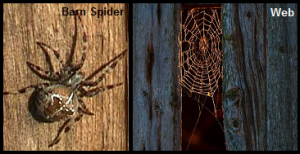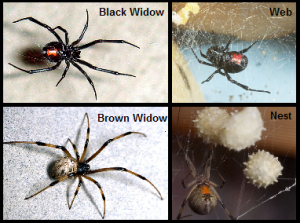These Spiders Live Too Close to Home!
Three Virginia spiders enjoy making your home their own: the American House Spider, the Black and Brown Widow Spiders, and the Barn Spider.
Web Design: American House Spiders create the common “cobweb”. This web is used for protection, molting, and storing egg sacs, as well as for catching food. The web is made to catch small insects, and when an insect gets stuck in the web, these spiders throw their silk over the insect like a blanket and proceeds to wrap it up tightly.
Favorite Hiding Spots:
- In houses, garages, and sheds
- Under eaves and porches
- In window frames
- Under furniture
- In closets
 Defense Mechanism: These spiders are cowardly! If their cobweb is disturbed they will drop from it and run away into the nearest crack or crevice.
Defense Mechanism: These spiders are cowardly! If their cobweb is disturbed they will drop from it and run away into the nearest crack or crevice.
Fun Fact: Although they are called the “American” House Spider, they are not only found in America, but all over the world!
Black Widow and Brown Widow Spiders
Web Design: Black and Brown Widows create webs with the common “cob web” design, but are sturdier than the American House Spiders’ webs. These webs have a tangled appearance, and are normally close to the ground in cracks and crevices or in rock piles. They can inhabit the holes of stacked bricks, between logs in woodpiles, in tree stumps, and in trash piles. Their webs are used for catching food and storing egg sacs, which are are small, tan, and oval. Their favorite insects are those that hop and crawl (such as grasshoppers, crickets, and flies).
- Dark and damp areas
- Inside of sheds, garages, and closets
- Outside near rocks, woodpiles, bricks, and trash
Defense Mechanism: These spiders are nocturnal hunters, and they only bite in self-defense or if they are brushed against. Their primary defense mechanism is the venom they produce. This is poisonous to humans but depends on how much venom is released into the body. Their venom is a neurotoxin, which means that the nerves are attacked in order to stun prey. Do not disturb the web, for they will think that they caught food and rush out to bite. If there are egg sacs, females will defend these aggressively. Sometimes the spiders will choose to hide instead of bite. In these cases, they will usually move into a dark corner of the web or stay still to blend in with their environment. The venom of Brown Widows is more toxic, however, they are less likely to bite and more likely to play dead when disturbed than Black Widows. Additionally, Brown Widow eggs have a rough appearance, while Black Widows have smooth eggs.
Symptoms of a Bite: The first symptom is slight pain where bitten, followed by sever muscle cramps, abdominal pain, weakness, and tremors. Severe cases may include nausea, vomiting, dizziness, faintness, chest pain, and respiratory difficulty. The severity of the reaction will depend on the amount of venom released, the age and physical condition of the person, and whether or not the person is allergic.
Fun Fact: The name “Widow” was given to these spiders under the misconception that the female always eats the male after mating. While this does occur, sometimes the male escapes unharmed!
Barn Spider
Web Design: Barn Spiders are a type of Orb Weaver, which means that they spin large circular webs. The web is mainly used to capture food, and their favorite snacks are insects that fly or crawl. These spiders will move the web through vibrations created by the spider’s movement in order to help ensnare their prey. Once an insect is caught, they will use the part of the web the insect is stuck in to wrap it up in a tight blanket. As a result, the web will become ragged and full of holes. When there are too many holes in the web, the spider will eat the web, and then recycle it to create a new web.
Favorite Hiding Spots:
-
Porches near light
-
In the corners of doorways and window frames
-
On the sides of cliffs, in caves, and in barns
 Defense Mechanism: Barn Spiders use their dark brown color as camouflage against predators during the day. They are only in their webs during the night, and spend the day in cracks and crevices. However, these spiders are also cowardly, and if their web is disturbed, they will drop from the web and run into a crack or crevice near by.
Defense Mechanism: Barn Spiders use their dark brown color as camouflage against predators during the day. They are only in their webs during the night, and spend the day in cracks and crevices. However, these spiders are also cowardly, and if their web is disturbed, they will drop from the web and run into a crack or crevice near by.
Fun Fact: The spider depicted in the book “Charlotte’s Web” by E.B. White is a barn spider!
Regardless of what species of spider that you’re having an issue with, PermaTreat is able to take care of your problem!



































































